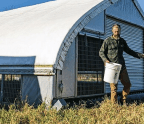

The Green Burial Council distinguishes a “green” burial with four criteria: “caring for the dead with the minimal environmental impact that aids in the conservation of natural resources, reduction of carbon emissions, protection of worker health, and restoration or preservation of habitat.” As of December 2023, the New Hampshire Funeral Resources, Education & Advocacy lists 443 cemeteries and burial grounds in the U.S. and Canada that have been reported to offer some form of natural burial.
Adjacent to these green burial options is a process that’s risen in popularity in recent years by promising a more affordable and climate-friendly death-care option called “human composting,” “body composting,” “natural organic reduction” (NOR), “soil transformation,” or “terramation.”
These are all names for an accelerated method of decomposing human remains. When a body is “composted,” remains are placed in a vessel with a combination of organic materials, such as wood chips, alfalfa, or straw. Supplying oxygen and heat speeds up the process, and naturally occurring microbes decompose the body. On average, it takes 30 to 180 days for assisted human decomposition to complete, depending on body size and the




